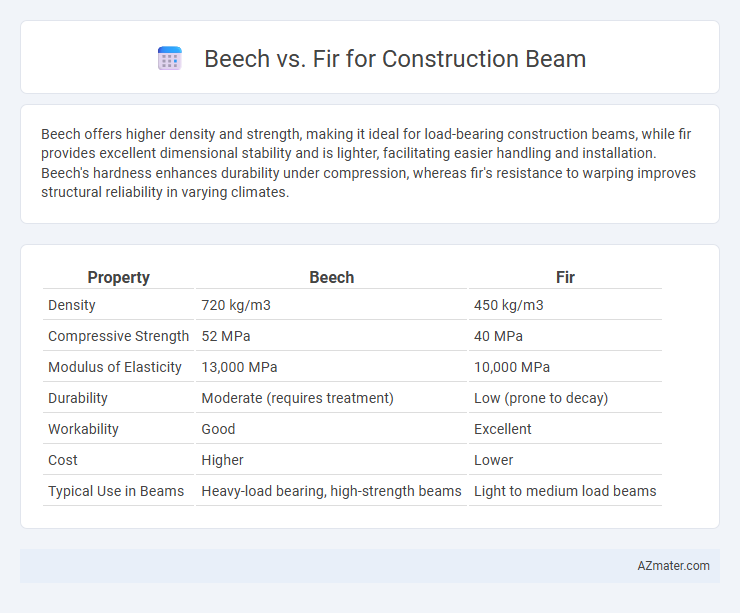Beech offers higher density and strength, making it ideal for load-bearing construction beams, while fir provides excellent dimensional stability and is lighter, facilitating easier handling and installation. Beech's hardness enhances durability under compression, whereas fir's resistance to warping improves structural reliability in varying climates.
Table of Comparison
| Property | Beech | Fir |
|---|---|---|
| Density | 720 kg/m3 | 450 kg/m3 |
| Compressive Strength | 52 MPa | 40 MPa |
| Modulus of Elasticity | 13,000 MPa | 10,000 MPa |
| Durability | Moderate (requires treatment) | Low (prone to decay) |
| Workability | Good | Excellent |
| Cost | Higher | Lower |
| Typical Use in Beams | Heavy-load bearing, high-strength beams | Light to medium load beams |
Introduction: Beech vs Fir in Construction
Beech and fir are commonly used hardwood and softwood respectively for construction beams, each offering distinct structural properties. Beech provides greater density and strength, making it suitable for heavy load-bearing applications requiring durability. Fir, known for its lightweight and straight grain, facilitates easier handling and offers good resistance to bending, ideal for cost-effective and efficient framing.
Wood Properties: Beech and Fir Overview
Beech wood, known for its high density and hardness, offers superior strength and durability, making it ideal for heavy-load construction beams, while its fine, close grain enhances its aesthetic appeal. Fir wood, characterized by its straight grain and lighter weight, provides excellent strength-to-weight ratio and natural resistance to decay, making it a practical choice for structural beams in framing and roofing. Both woods exhibit good workability and stability, but Beech's higher Janka hardness value of 1300 lbf compared to Fir's 660 lbf reflects its greater resistance to wear and denting under load.
Strength and Durability Comparison
Beech wood exhibits high hardness and excellent wear resistance, making it suitable for construction beams that require strength and durability under heavy loads. Fir, specifically Douglas Fir, offers superior tensile strength and natural resistance to decay, often favored in structural applications where long-term stability is critical. Comparing both, fir beams provide better strength-to-weight ratios and durability in outdoor environments, while beech beams excel in indoor use due to their dense grain and resistance to compression.
Weight and Density Differences
Beech wood typically has a density around 700 kg/m3, making it heavier and more durable compared to fir, which has a density near 450 kg/m3. The higher density of beech results in greater strength and resistance to bending, making it suitable for structural beams requiring high load-bearing capacity. Fir's lighter weight eases handling and reduces overall construction weight but may require additional support in high-stress applications due to its lower density.
Workability and Machinability
Beech offers excellent workability due to its fine, even texture and hardness, making it easy to shape, plane, and sand for precise construction beams. Fir, while slightly less dense, boasts good machinability with fewer blunting effects on cutting tools, allowing efficient processing and consistent results. Both woods provide reliable options for construction beams, but Beech is preferred when superior surface finish and detailed craftsmanship are required.
Resistance to Decay and Insects
Beech wood exhibits moderate resistance to decay and insect attacks, making it less ideal for long-term structural applications exposed to moisture or pests. Fir, especially Douglas Fir, offers superior natural durability and resistance against decay and insects, enhancing its suitability for construction beams in outdoor or high-humidity environments. Selecting fir beams ensures greater longevity and structural integrity in challenging conditions compared to beech.
Cost and Availability
Beech beams typically cost more than fir due to their denser grain and hardwood classification, resulting in increased strength but higher price per board foot. Fir is generally more readily available in North America, making it a cost-effective choice for construction beams with acceptable load-bearing properties in many structural applications. Availability of fir lumber in various grades supports its popularity, while beech's limited regional supply can increase lead times and affect overall project budget.
Environmental Impact and Sustainability
Beech and fir differ significantly in environmental impact and sustainability for construction beams. Fir is often favored due to its faster growth rate and greater availability, resulting in a lower carbon footprint and more sustainable harvesting practices. Beech, being a slower-growing hardwood, is less sustainable but offers higher density and durability, impacting reusability and long-term environmental considerations.
Ideal Applications for Beech and Fir Beams
Beech beams excel in interior construction applications requiring high strength and aesthetic appeal, such as flooring, furniture frames, and decorative finishes due to their fine grain and durability. Fir beams are ideal for structural applications including roof trusses, framing, and outdoor construction where lightweight strength and resistance to decay are critical. Both wood types offer distinct advantages--Beech for dense, wear-resistant uses and Fir for flexible, load-bearing structures exposed to varying environmental conditions.
Conclusion: Choosing the Right Wood for Construction Beams
Beech offers superior hardness and durability, making it ideal for heavy-load construction beams where impact resistance is crucial. Fir provides excellent strength-to-weight ratio and natural stability, suitable for structural beams requiring ease of handling and dimensional consistency. Selecting between Beech and Fir depends on the specific load demands, environmental exposure, and budget constraints of the construction project.

Infographic: Beech vs Fir for Construction Beam
 azmater.com
azmater.com